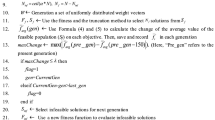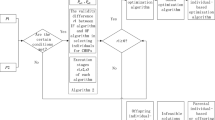Abstract
This paper proposes an improved epsilon constraint-handling mechanism and combines it with a decomposition-based multi-objective evolutionary algorithm (MOEA/D) to solve constrained multi-objective optimization problems (CMOPs). The proposed constrained multi-objective evolutionary algorithm (CMOEA) is named MOEA/D-IEpsilon. It adjusts the epsilon level dynamically according to the ratio of feasible to total solutions in the current population. In order to evaluate the performance of MOEA/D-IEpsilon, a new set of CMOPs with two and three objectives is designed, having large infeasible regions (relative to the feasible regions), and they are called LIR-CMOPs. Then, the 14 benchmarks, including LIR-CMOP1-14, are used to test MOEA/D-IEpsilon and four other decomposition-based CMOEAs, including MOEA/D-Epsilon, MOEA/D-SR, MOEA/D-CDP and CMOEA/D. The experimental results indicate that MOEA/D-IEpsilon is significantly better than the other four CMOEAs on all of the test instances, which shows that MOEA/D-IEpsilon is more suitable for solving CMOPs with large infeasible regions. Furthermore, a real-world problem, namely the robot gripper optimization problem, is used to test the five CMOEAs. The experimental results demonstrate that MOEA/D-IEpsilon also outperforms the other four CMOEAs on this problem.








Similar content being viewed by others
Explore related subjects
Discover the latest articles, news and stories from top researchers in related subjects.References
Asafuddoula M, Ray T, Sarker R, Alam K (2012) An adaptive constraint handling approach embedded MOEA/D. In: 2012 IEEE Congress on Evolutionary Computation. IEEE, pp 1–8
Bader J, Zitzler E (2011) HypE: an algorithm for fast hypervolume-based many-objective optimization. Evol Comput 19(1):45–76
Beume N, Naujoks B, Emmerich M (2007) SMS-EMOA: multiobjective selection based on dominated hypervolume. Eur J Oper Res 181(3):1653–1669
Bosman PA, Thierens D (2003) The balance between proximity and diversity in multiobjective evolutionary algorithms. IEEE Trans Evol Comput 7(2):174–188
Cai X, Hu Z, Fan Z (2013) A novel memetic algorithm based on invasive weed optimization and differential evolution for constrained optimization. Soft Comput 17(10):1893–1910
Cai X, Li Y, Fan Z, Zhang Q (2015) An external archive guided multiobjective evolutionary algorithm based on decomposition for combinatorial optimization. IEEE Trans Evol Comput 19(4):508–523
Cai X, Yang Z, Fan Z, Zhang Q (2017) Decomposition-based-sorting and angle-based-selection for evolutionary multiobjective and many-objective optimization. IEEE Trans Cybern 47(9):2824–2837
Coello Coello CA (2002) Theoretical and numerical constraint-handling techniques used with evolutionary algorithms: a survey of the state of the art. Comput Methods Appl Mech Eng 191(11–12):1245–1287
Corne DW, Jerram NR, Knowles JD, Oates MJ (2001) PESA-II: region-based selection in evolutionary multiobjective optimization. In: Proceedings of the 3rd annual conference on genetic and evolutionary computation. Morgan Kaufmann, pp 283–290
Črepinšek M, Liu SH, Mernik M (2013) Exploration and exploitation in evolutionary algorithms: a survey. ACM Comput Surv 45(3):35
Datta R, Deb K (2011) Multi-objective design and analysis of robot gripper configurations using an evolutionary-classical approach. In: Conference on genetic and evolutionary computation, pp 1843–1850
Deb K (2001) Multi-objective optimization using evolutionary algorithms, vol 16. Wiley, London
Deb K, Jain H (2014) An evolutionary many-objective optimization algorithm using reference-point-based nondominated sorting approach, part I: solving problems with box constraints. IEEE Trans Evol Comput 18(4):577–601
Deb K, Pratap A, Agarwal S, Meyarivan T (2002) A fast and elitist multiobjective genetic algorithm: NSGA-II. IEEE Trans Evol Comput 6(2):182–197
Derrac J, García S, Molina D, Herrera F (2011) A practical tutorial on the use of nonparametric statistical tests as a methodology for comparing evolutionary and swarm intelligence algorithms. Swarm Evol Comput 1(1):3–18
Dunn OJ (1961) Multiple comparisons among means. J Am Stat Assoc 56(293):52–64
Fan Z, Li W, Cai X, Li H, Hu K, Zhang Q, Deb K, Goodman ED (2016) Difficulty adjustable and scalable constrained multi-objective test problem toolkit. arXiv preprint arXiv:1612.07603
Finner H (1993) On a monotonicity problem in step-down multiple test procedures. J Am Stat Assoc 88(423):920–923
Hochberg Y (1988) A sharper Bonferroni procedure for multiple tests of significance. Biometrika 75(4):800–802
Holland BS, Copenhaver MD (1987) An improved sequentially rejective Bonferroni test procedure. Biometrics 43:417–423
Holm S (1979) A simple sequentially rejective multiple test procedure. Scand J Stat 6:65–70
Hommel G (1988) A stagewise rejective multiple test procedure based on a modified Bonferroni test. Biometrika 75(2):383–386
Hu Z, Cai X, Fan Z (2013) An improved memetic algorithm using ring neighborhood topology for constrained optimization. Soft Comput 18(10):2023–2041
Huband S, Hingston P, Barone L, While L (2006) A review of multiobjective test problems and a scalable test problem toolkit. IEEE Trans Evol Comput 10(5):477–506
Jan MA, Khanum RA (2013) A study of two penalty-parameterless constraint handling techniques in the framework of MOEA/D. Appl Soft Comput 13(1):128–148
Jiang S, Zhang J, Ong YS, Zhang AN, Tan PS (2015) A simple and fast hypervolume indicator-based multiobjective evolutionary algorithm. IEEE Trans Cybern 45(10):2202–2213
Li JD (2008) A two-step rejection procedure for testing multiple hypotheses. J Stat Plann Inference 138(6):1521–1527
Li H, Zhang Q (2009) Multiobjective optimization problems with complicated pareto sets, MOEA/D and NSGA-II. IEEE Trans Evol Comput 13(2):284–302
Liu HL, Gu F, Zhang Q (2014) Decomposition of a multiobjective optimization problem into a number of simple multiobjective subproblems. IEEE Trans Evol Comput 18(3):450–455
Mezura-Montes E, Coello Coello CA (2011) Constraint-handling in nature-inspired numerical optimization: past, present and future. Swarm Evol Comput 1(4):173–194
Miettinen K (1999) Nonlinear multiobjective optimization, vol 12. Springer, Berlin
Rom DM (1990) A sequentially rejective test procedure based on a modified Bonferroni inequality. Biometrika 77(3):663–665
Runarsson TP, Yao X (2000) Stochastic ranking for constrained evolutionary optimization. IEEE Trans Evol Comput 4(3):284–294
Runarsson TP, Yao X (2005) Search biases in constrained evolutionary optimization. IEEE Trans Syst Man Cybern Part C Appl Rev 35(2):233–243
Saravanan R, Ramabalan S, Ebenezer NGR, Dharmaraja C (2009) Evolutionary multi criteria design optimization of robot grippers. Appl Soft Comput 9(1):159–172
Takahama T, Sakai S (2006) Constrained optimization by the \(\varepsilon \) constrained differential evolution with gradient-based mutation and feasible elites. In: 2006 IEEE international conference on evolutionary computation. IEEE, pp 1–8
Yang Z, Cai X, Fan Z (2014) Epsilon constrained method for constrained multiobjective optimization problems: some preliminary results. In: Proceedings of the Companion Publication of the 2014 Annual Conference on Genetic and Evolutionary Computation, ACM, pp 1181–1186
Zhang Q, Li H (2007) MOEA/D: a multiobjective evolutionary algorithm based on decomposition. IEEE Trans Evol Comput 11(6):712–731
Zhang Q, Zhou A, Zhao S, Suganthan PN, Liu W, Tiwari S (2008) Multiobjective optimization test instances for the CEC 2009 special session and competition. University of Essex, Colchester, UK and Nanyang Technological University, Singapore, special session on performance assessment of multi-objective optimization algorithms, Technical report 264
Zitzler E, Künzli S (2004) Indicator-based selection in multiobjective search. In: International conference on parallel problem solving from nature. Springer, pp 832–842
Zitzler E, Thiele L (1999) Multiobjective evolutionary algorithms: a comparative case study and the strength Pareto approach. IEEE Trans Evol Comput 3(4):257–271
Zitzler E, Laumanns M, Thiele L (2001) SPEA2: Improving the strength Pareto evolutionary algorithm. TIK-report 103
Acknowledgements
This work was supported in part by the National Natural Science Foundation of China (NSFC) under Grants 61300159, 75661473241 and 61332002, by the Natural Science Foundation of Jiangsu Province of China under Grant SBK2018022017, by the Project of International as well as Hong Kong, Macao & Taiwan Science and Technology Cooperation Innovation Platform in Universities in Guangdong Province under Grant 2015KGJH2014, by China Postdoctoral Science Foundation under Grant 2015M571751, by the Science and Technology Planning Project of Guangdong Province of China under Grant 2013B011304002, by Educational Commission of Guangdong Province of China under Grant 2015KGJHZ014, by the Fundamental Research Funds for the Central Universities of China under Grant NZ2013306, by the Guangdong High-Level University Project “Green Technologies” for Marine Industries, by the Scientific Startup Research Foundation of Shantou University under Grant NTF12024 and by the State Key Lab of Digital Manufacturing Equipment & Technology under grant DMETKF2019020.
Author information
Authors and Affiliations
Corresponding author
Ethics declarations
Conflict of interest
The authors declare that they have no conflict of interest.
Ethical approval
This article does not contain any studies with human participants or animals performed by any of the authors.
Additional information
Communicated by V. Loia.
Publisher's Note
Springer Nature remains neutral with regard to jurisdictional claims in published maps and institutional affiliations.
Appendix
Appendix
In this section, the detailed definitions of LIR-CMOP1-14 are listed in Table 8. The source codes of MOEA/D-IEpsilon and LIR-CMOPs can be found in the Web site.Footnote 2
Rights and permissions
About this article
Cite this article
Fan, Z., Li, W., Cai, X. et al. An improved epsilon constraint-handling method in MOEA/D for CMOPs with large infeasible regions. Soft Comput 23, 12491–12510 (2019). https://doi.org/10.1007/s00500-019-03794-x
Published:
Issue Date:
DOI: https://doi.org/10.1007/s00500-019-03794-x




